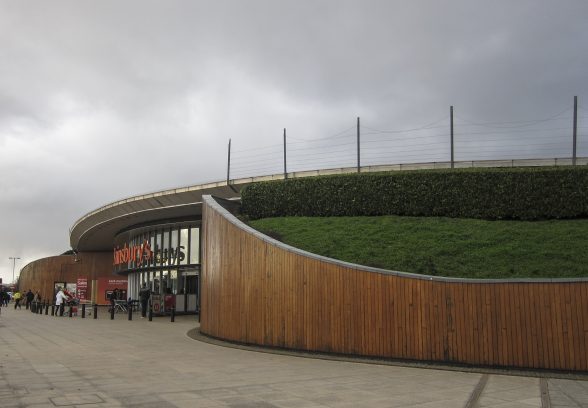This website uses cookies
This website uses cookies to enable it to function properly and to analyse how the website is used. Please click 'Close' to accept and continue using the website.



The Twentieth Century Society is disappointed by the decision issued this week not to list the Sainsbury’s eco-millennium store. The award winning Sainsbury’s on the Greenwich peninsula, south east London – which is still open – is scheduled for demolition and replacement with an IKEA superstore in 2015.
Following English Heritage’s recommendation, the Secretary of State has decided not to list the building and to grant immunity from designation for 5 years.
The building, designed by Paul Hinkin when he worked for Chetwood Associates, was short-listed for the Stirling Prize, and represented a complete re-think of traditional supermarket design. Every aspect of the standard retail ‘shed’ was re-assessed to maximise energy efficiency, minimise the impact on the environment and improve the experience for customers.
Henrietta Billings, Senior Conservation Adviser, Twentieth Century Society said, “We are deeply disappointed with the decision not to list the Sainsbury’s millennium store. It was the most innovative supermarket building to have been built in the last 50 years, and it was in our view, the best and most obvious candidate for listing. This is just the type of retail architecture we should be celebrating and not demolishing.
The irony is that this unique building now looks set to be lost and replaced with the type of traditional retail ‘box’ design that Paul Hinkin and his team so successfully challenged and re-thought.”
This pioneering and award winning supermarket, which was built in 1999, would have been the youngest building, and the first ever purpose built supermarket to be listed. Because of its recent date, it would have had to be listed at grade II* or grade I. Only eight per cent of listed buildings in England fall within this category.
In its assessment report, English Heritage remarked upon the, “graceful, humanised and inspiring” design. They described the supermarket as, “perhaps the company’s most striking and instantly recognisable foray into high profile architectural design”. They added, “The building is a product of its time, both architecturally and conceptually, demonstrating that even the most mundane building type could be transformed into something sensitive to its environment: it gave physical form to the aspiration of a clean, green, twenty first century.”
However English Heritage concluded that the building did not meet the high bar for special interest set by listing at grade II * because of its “lack of flexibility”, and that despite being a one-off sustainable ‘concept store’, it is “not of sufficient importance as a pioneer of, or turning point for, sustainable retail architecture.”
Ends
Notes for editors:
Contemporary reviews: The opening of the Sainsbury’s Greenwich store in 1999 by Jamie Oliver was widely covered in the national press. Although there was keen popular interest in the building’s sustainability credentials, its architectural quality was also widely recognised. Reviews published at the time noted that ‘in appearance as well as sustainable design, the new building breaks with the dismal supermarket tradition of large, rectangular, artificially lit sheds’ (Building, 1999). The RIBA Journal (November 1999) stated that: “The form of the external design is frankly lovely. The main entrance elevation uses surprisingly welcoming materials, with the main glazed entrance flanked by untreated oak boarded drums with flank walls, earth mounds and turfed slopes. The service areas are masked using site reclaimed stones within wire gabion baskets filled with demolition waste and planted with creepers and alpines.”
Awards: The building’s innovation and architectural merit were recognised through a number of awards, including:
• shortlisted for the Stirling Prize (we believe no other supermarket has been shortlisted for this prize before or since);
• selection by the Design Council as a Millennium Product;
• the RIBA Journal Sustainability Award winner;
• a RIBA Regional Award 2000 winner;
• the Design Museum’s Design Sense Award;
• Retail Week Store Design of the Year 2000;
• Channel 4 Building of the Year People’s Choice 2000.
An online petition against the demolition was set up by Paul Hinkin: http://www.petitionbuzz.com/petitions/stopikea.
It has been signed by over 1500 people including the former President of RIBA Angela Brady and Mayor of Bristol George Ferguson.
For more information please contact Henrietta Billings on 020 7250 3857 or Henrietta@c20society.org.uk

Become a C20 member today and help save our modern design heritage.